![]()
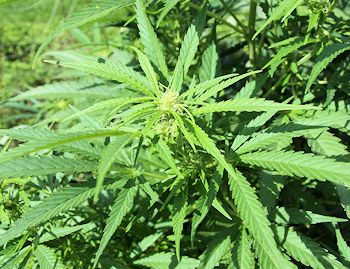 Cannabis plant |
Cannabidiol (CBD)
|
|
Simon Cotton
Molecule of the Month April 2019
| |
Cannabis is strictly the name given to a genus of plants, though when people say ‘cannabis’ they usually mean Cannabis sativa, the stuff that hemp - and also the drug - is obtained from. Marijuana is the name of the drug, but most people use the words cannabis and marijuana interchangeably. There are several types of marijuana, like bhang (from the leaves, seeds and stem), ganja (from the flowering tops), and hashish (pure resin from the flowers).
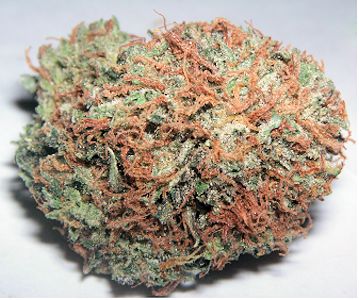 |
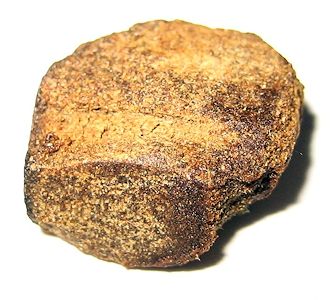 |
 |
| Dried cannabis flowers. Photo: Coaster420 [Public domain] via Wikimedia Commons |
Hashish. Photo: Erik Fenderson [Public domain] via Wikimedia Commons |
A slow-burning ‘joint’ filled with cannabis. Photo: Torben Hansen [CC BY 2.0] via Wikimedia Commons |
How long has it been around?The Chinese were very likely the first people to cultivate the plants, around 6,000 years ago, in order to get hemp for making rope. Subsequently, other applications like clothing have been found. It seems that medicinal uses were discovered around 2,000 years ago. Like many other people of the time in 18th century North America, George Washington grew it to make hemp for rope and sacks, but not, it seems, for consumption! So how did it get into Western culture?It was widely used in the Middle East during the first millennium AD (it is not prohibited by the Koran, as it is not “intoxicating”) and from there found its way into Europe. It seems that Indian workers took marijuana to the West Indies, from where it was only a short step to the American continent. It certainly reached France in the early nineteenth century, with the great poet Charles Baudelaire among the users. The medicinal uses of “tincture of hemp” for a whole range of complaints were known, so it became a component of Dr J. Collis Browne’s Chlorodyne, an alleged 'medicinal' liquid introduced into the UK around 1850. This panacea was claimed to treat dysentery, diarrhoea, cholera, insomnia, neuralgia, bronchitis, and asthma, among others. Because Chlorodyne contained alcohol, morphine and cannabinoids, its powers were irresistible to some users, and it was subsequently reformulated (there are no cannabinoids in the current version). |
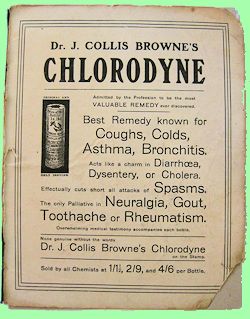 Photograph of an advert for Chlorodyne in a book from 1907. |
In the 1930s, marijuana was associated with jazz musicians – Louis Armstrong was busted for it in 1931 - whilst in the ‘40s and ‘50s cheap paperback novels (“yellow fiction”) regularly featured 'reefers' (marijuana-based cigarettes) leading innocents into lives of shame and depravity. With the expansion in higher education, it reached universities in the USA in the ‘50s and ‘60s. It is said that when Bob Dylan made his Blonde on Blonde album in 1966 he was high on cannabis, and the opening song “Rainy Day Women # 12 & 35”, includes the words “everyone must get stoned”. Other Dylan songs like “Mr Tambourine Man” were also influenced by it. It was Dylan who introduced the Beatles to marijuana; Paul McCartney’s tribute to marijuana, "Got to Get You Into My Life", was written for the 1966 Revolver album. In February 1967, Keith Richards, the Rolling Stones’ guitarist, was arrested and sentenced to a year’s imprisonment for allowing cannabis to be smoked at his home – though he was later acquitted on appeal over the trivial detail that there had been no cannabis on the premises. As a Rastafarian, Bob Marley used ganja (the Jamaican word for marijuana) and this influenced the development of reggae (with his albums Kaya, Redder than Red and African Herbsman).
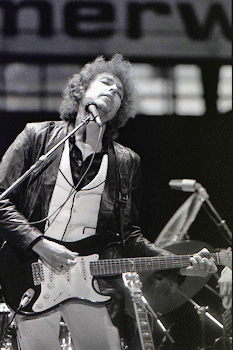 |
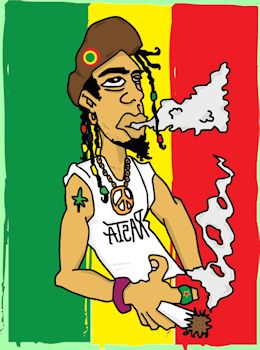 |
| Bob Dylan in 1978. | In the 1970s, Rastafarians popularised ganja as part of their religion and reggae music. |
A combination of the Vietnam War and the hippy trail to Kathmandu helped spread the pot habit, whilst ex-President Bill Clinton smoked it when in college but famously 'did not inhale'. Even the clean-cut housewives’ favourite singer, John Denver, didn’t escape controversy over the drug, when his song Rocky Mountain High was banned by the US Federal Communications Committee in 1973, who thought it was promoting drug use. Eventually, John Denver managed to persuade the FCC that in innocently using the word ‘high’, he was simply describing the sense of peace and awe he found in the Rockies, and the song was unbanned. And in 1978, the Canadian prog-rock group Rush described the various locations in the world notorious for growing cannabis in their song A Passage to Bangkok, with the lyrics "we'll only stop for the best".
In 2005, cannabis use was the focus of a popular US TV series called Weeds, which concerned the story of a widowed mother who began selling marijuana to support her family after her husband suddenly died. The show explored the controversial issues and ‘problem’ of the illegality of the drug.
 The use of cannabis for recreational purposes has been illegal in most countries since the start of the 20th century. This is despite it not being addictive and arguably being far less harmful than many legal drugs, such as alcohol or tobacco. Even so, according to the United Nations World Drug Report 2012, cannabis is the most widely used illicit substance globally, with nearly 1-in-20 of the adult population in the world using it at least once a year! As well as the problem of maintaining the ban on such a widely used substance, the recent advent of ‘medical marijuana’ has made the issue even more bizarre. In some US States it is currently illegal to buy marijuana for recreational use, but if you have certain medical conditions, such as multiple sclerosis or chronic pain, it is possible to buy the same marijuana perfectly legally!
The use of cannabis for recreational purposes has been illegal in most countries since the start of the 20th century. This is despite it not being addictive and arguably being far less harmful than many legal drugs, such as alcohol or tobacco. Even so, according to the United Nations World Drug Report 2012, cannabis is the most widely used illicit substance globally, with nearly 1-in-20 of the adult population in the world using it at least once a year! As well as the problem of maintaining the ban on such a widely used substance, the recent advent of ‘medical marijuana’ has made the issue even more bizarre. In some US States it is currently illegal to buy marijuana for recreational use, but if you have certain medical conditions, such as multiple sclerosis or chronic pain, it is possible to buy the same marijuana perfectly legally!
It is currently legal to use marijuana medicinally in some countries like Canada and South Africa, as well as certain US states. There are some countries like Uruguay where it is legal to sell cannabis and a number are discussing its decriminalisation. This is complex and fast-moving.
Smoking it makes people feel happy and self-confident. Its effects include making time seem longer and the world seem more mellow. It affects short-term memory, peripheral vision, reaction time, and coordination.
Marijuana contains nearly 500 different chemicals. The most important one as far as psychoactive properties are concerned is Δ-9-tetrahydrocannabinol, also known as delta-9-THC (Δ9-THC). Nature, being a brilliant synthetic chemist, just makes the single-isomer (–)-Δ9-THC. It is possible to make the other isomer in the laboratory, but (+)-Δ9-THC has no psychoactive properties.
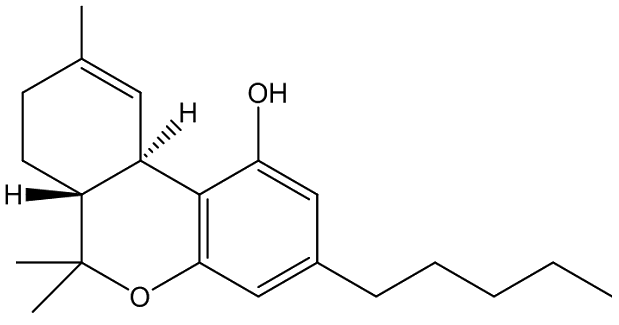 |
|
| Δ9-THC |
THC is made in the leaves of the cannabis plant, the first step being the biosynthesis of Δ-9-tetrahydrocannabinolic acid (THCA) from cannabigerolic acid (CBGA). A living plant contains very little Δ9-THC, but THCA readily eliminates carbon dioxide to form Δ9-THC, even by just drying the plant.
If cannabis is smoked, Δ9-THC is transported by the blood from lungs to brain within seconds, in the same way as is nicotine (MOTM August 2001). Δ9-THC acts on two 'cannabinoid receptors' in the human body. One of them (called CB2) is found in areas like the immune system, but CB1 is prominent in the brain (and is also found in the lungs, liver, and kidneys). It is when Δ9-THC binds to CB1 that hallucinogenic effects are produced. It sets off several cell-signalling pathways, and also affects the release of noradrenaline, a neurotransmitter. There are natural molecules – anandamide (MOTM September 2009) is the best known - that also bind to these 'cannabinoid receptors'. In fact, these receptors should really be called ‘anandamide receptors’, since they are intended for anandamide, not THC.
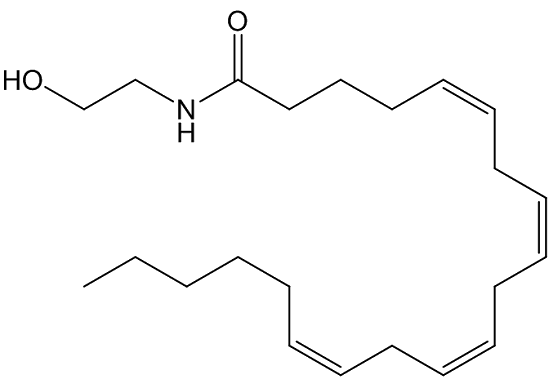 |
|
| Anandamide |
Anandamide, discovered in 1992, is thought to be involved in the regulation of feeding, pain control and the pleasure response. THC just happens to be the right shape to fit the anandamide receptors, thereby fooling the brain by giving it false feelings of pleasure.
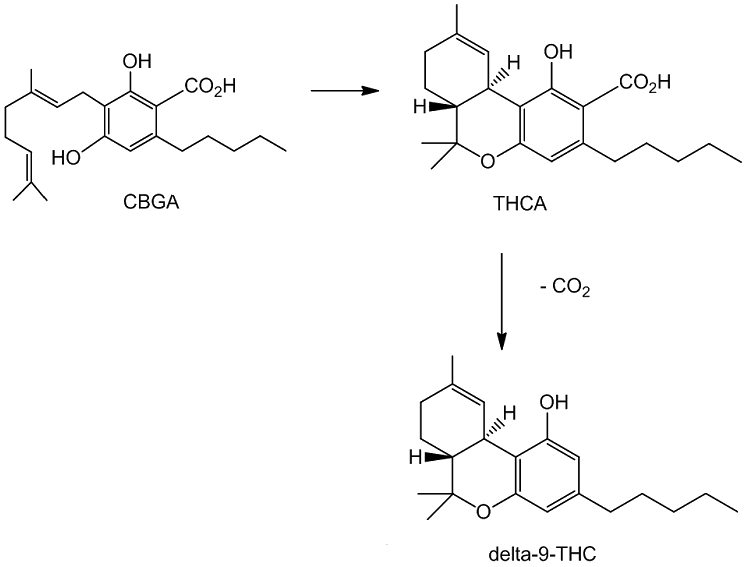
Δ9-THC is not the only important chemical in cannabis. By itself, it can produce feelings of panic, but these are alleviated in cannabis by another chemical present called cannabidiol, which is not psychoactive (and may, as we’ll see, have other useful therapeutic properties).
So, it is just a drug that some people find pleasant?Although most people use marijuana for the “high”, it does have medicinal uses, which were widely studied in the second half of the 19th century. Sir John Russell Reynolds, Queen Victoria’s personal physician, promoted the medicinal use of cannabis for dysmenorrhoea (period pains) in the 19th century, but he is unlikely to have recommended it to the Queen. Would she have been amused? Patients suffering from a variety of illnesses claim that smoking marijuana helps alleviate many of their symptoms. It is reported to reduce nausea and vomiting in cancer patients. When the famous biologist Stephen Jay Gould was being treated for abdominal mesothelioma cancer, he smoked marijuana to reduce the effects of the nausea he suffered from his chemotherapy and said “marijuana worked like a charm”. It acts as an appetite enhancer in AIDS patients, whilst multiple sclerosis patients say that it reduces muscle cramps, and paraplegics and quadriplegics report it to help control involuntary muscle spasms. An extract from cannabis is reported to lower the pressure in the eye-fluid, and this could be useful in glaucoma patients. |
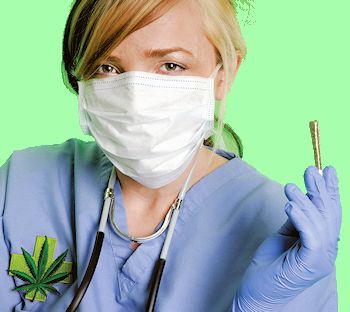 Medical marijuana? Or just a legal high? |
As far as commercial sources go, Sativex™, which contains THC and cannabidiol, is approved for use in the UK as well as New Zealand, Canada, Germany and several other European countries. It is an oromucosal spray administered into the mouth for the treatment of spasticity in multiple sclerosis patients, for neuropathic pain and other symptoms, and as a painkiller for cancer patients. The pure isomer (–)-Δ9-THC is known as dronabinol (trade name Marinol™) and is marketed in the USA as a Schedule III drug, available on prescription for the treatment of anorexia, nausea and vomiting in AIDS patients. A synthetic cannabinoid called Nabilone (marketed as Cesamet in Canada) finds similar applications.
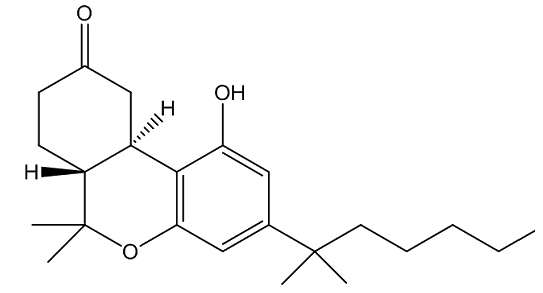 |
|
| Nabilone |
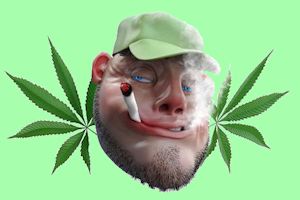 The smoke from a reefer contains over 150 different compounds, including toxic molecules such as CO, HCN and the carcinogen benzopyrene. Some of these occur at higher levels than in tobacco smoke.
The smoke from a reefer contains over 150 different compounds, including toxic molecules such as CO, HCN and the carcinogen benzopyrene. Some of these occur at higher levels than in tobacco smoke.
Research suggests that around 9% of cannabis users become dependent. It is widely believed that there is no link between taking cannabis use and moving on to cocaine and heroin; this may be true of some users, but there are sad stories where it does seem that it primes the brain to seek other, “harder”, narcotic substances, and so is often called a 'gateway drug'. Some of the molecules in cannabis, like Δ9-THC, look to have useful medical properties, but smoking is a very unsafe way of delivering the molecules — not least because of the risk of illnesses associated with smoking, such as lung cancer and bronchitis. Although no one has yet made any long-term study of marijuana smokers, it is unlikely to be a healthy option.
Well, there is cannabidiol (CBD).
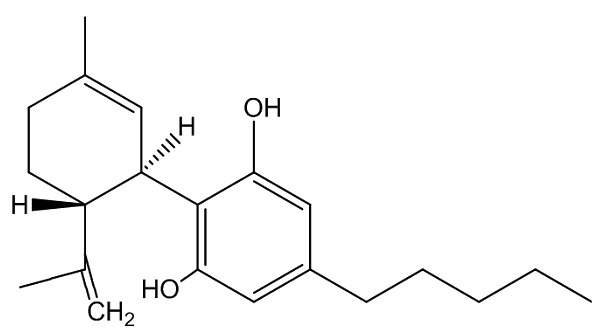 |
|
| Cannabidiol |
It is another secondary metabolite made by the plant, a cannabinoid.
No, the word 'cannabinoid' just means they interact with ‘cannabinoid receptors’ in the body, of which there are a number; the CB1 receptor in the brain happens to be the best known one, the one to which Δ9-THC binds. There are over 60 different ‘cannabinoid’ molecules produced by the cannabis plant, and Δ9-THC is the only ‘mind-altering molecule’ among them. CBD does not appear to have any psychoactive ("high") effects such as those caused by Δ9-THC in marijuana.
If anything, CBD seems to be an antagonist for CB1 receptors. Traditionally in cannabis there were comparable amounts of Δ9-THC and CBD, but high-potency cannabis (‘skunk’) can have much more THC, up to 16-22%, compared with 0.1% CBD or less, and that may be linked with possible mental health problems associated with ‘skunk’.
Some research has monitored levels of THC and CBD in peoples’ hair, and found that people with high THC levels but no CBD are more likely to show positive schizophrenia-like symptoms than those with both THC and CBD, or with no cannabinoids at all. Tests on 48 (healthy) volunteers showed that 42% had psychotic episodes after THC injections, which decreased to only 14% if they had a tablet of CBD before the THC injection.
Studies carried out on mice showed that those exposed to THC by itself showed signs of impaired memory and increased obsessive-compulsive behavior immediately after treatment, whilst those exposed to CBD alone had no behavioural changes in the short term or long term; similar findings were reported with mice who received CBD along with THC.
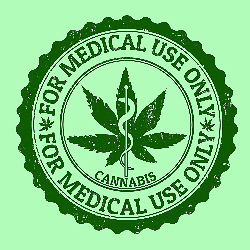 And cannabidiol has medicinal uses?
And cannabidiol has medicinal uses?For a long while there has been interest in using marijuana to treat epilepsy. Obviously using marijuana itself is not ideal, because of the effects of the THC. There is now evidence that CBD has been found to have encouraging effects upon two quite rare types of epilepsy, which come on in childhood, both of which cause slow development of motor skills as well as learning problems. It reduces the frequency of convulsive seizures in patients with Dravet syndrome, and the frequency of drop seizures in patients with Lennox-Gastaut syndrome. Most studies so far have reported on children and adolescents. In June 2018, the U.S. Food and Drug Administration recommended approval of the epilepsy medication, a strawberry-flavoured syrup based on cannabidiol and called Epidiolex, for the treatment of Lennox-Gastaut syndrome and Dravet syndrome.
People have suggested that it may be useful in treating various addictions, but the evidence so far seems to be conflicting, so that more study is needed. It has been claimed that CBD may reduce craving in smokers who are trying to give up, but a more recent study has said that cannabidiol did not influence tobacco craving or withdrawal or any subjectively rated side effects. Other studies indicate that it may reduce some psychiatric disorders and symptoms like anxiety, insomnia and pain, which are often associated with substance abuse.
Yes, but it needs proper controlled study, without hype from people with something to gain (‘Cui Bono?’).
![]()
The literature on marijuana and THC is vast, so much of the work cited here is general in nature. It has been possible to cite a higher proportion of CBD publications, which have been grouped into specific categories.
![]()
![]() Back to Molecule of the Month page. [DOI:10.6084/m9.figshare.7284920]
Back to Molecule of the Month page. [DOI:10.6084/m9.figshare.7284920]